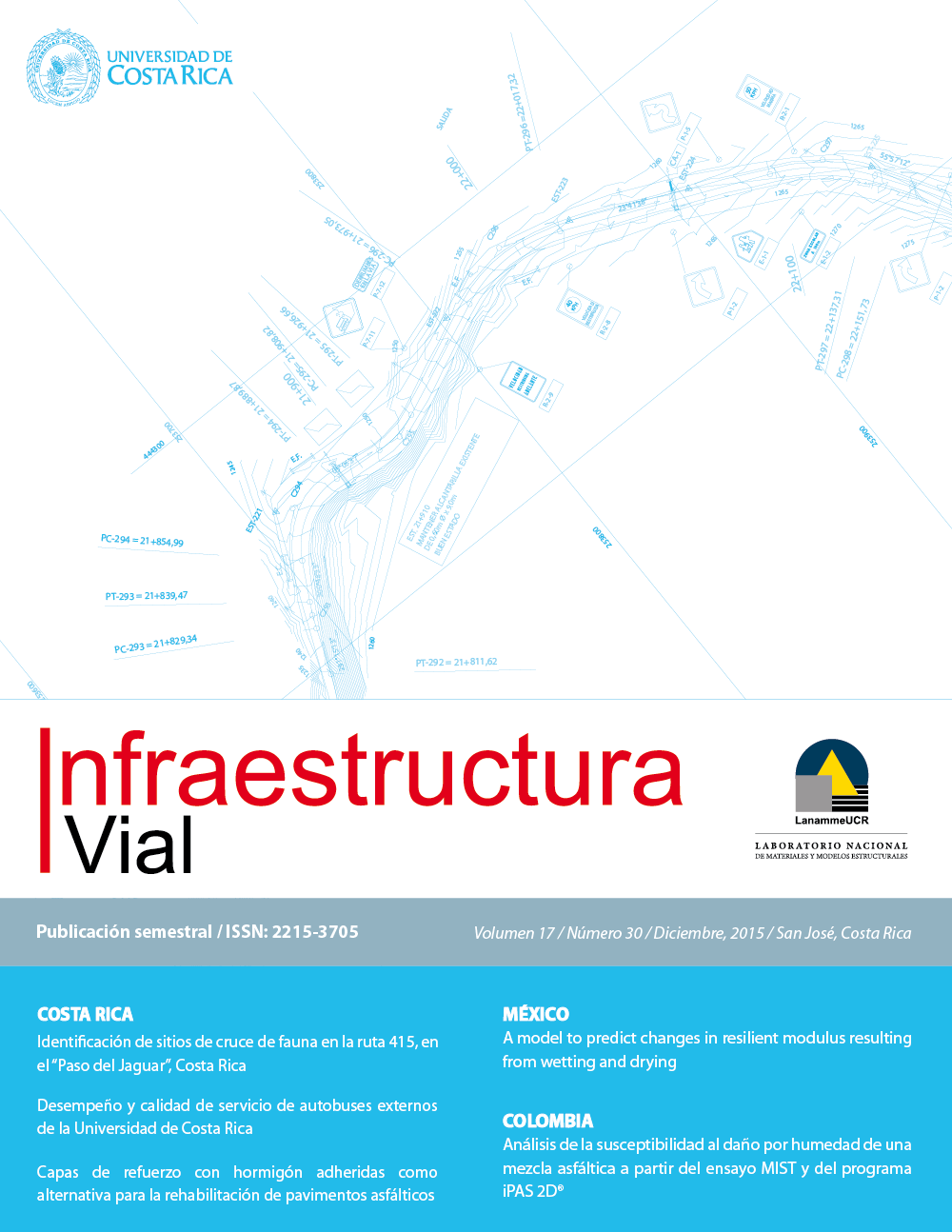Abstract
The resilient modulus of a soil is an important parameter needed for pavement design. However, this parameter experiences post-compaction seasonal changes during the service life of the pavement as a result of wetting or drying of the soil during dry or rainy periods. Variations in the resilient modulus should be introduced into pavement design methodologies. Research literature shows resilient modulus results from other countries; however, the information is scarce for Mexican soils. In this paper, the authors show results of a research carried out in the laboratory to evaluate a model for the prediction of the effect of wetting and drying on the resilient modulus of soils classified as clays, silt, and sand. Several samples were prepared at optimum conditions using the Proctor standard test. Some specimens were then dried by allowing a loss of water through evaporation while others were allowed to gain water through capillarity (assumed to simulate post-compaction conditions). After the samples were conditioned to new water contents, resilient modulus tests were performed following the NCHRP 1-28A protocol. The results show that the resilient modulus can be predicted using a model which is a function of the deviator stress and confining pressure (i.e., (sd/s3) and the variation of water content from optimum water content conditions (i.e., the condition after field compaction). The R2 results when using the proposed resilient modulus model was 84.1%.References
Baladi, G.Y., Dawson, T.A., and Haider, S.W. (2009). Laboratory Subgrade Resilient Modulus Design Values for the State of Michigan. 88th Transportation Research Board Annual Meeting. Washington D.C.
Baladi, G.Y., Sessions, C.P., and Haider, S.W. (2009). Backaclculated and Laboratory Measured Resilient Modulus Values. 88th Transportation Research Board Annual Meeting. Washington D.C.
Bayomy, F., El-Badawy, S., Awed, A. (2012). Implementation of the MEPDG for Flexible Pavements in Idaho. Report No. FHWA-ID-12-193. National Institute dor Advanced Transportation Technology, University of Idaho. Prepared for Idaho Transportation Division of Highways, Resource Center. May 2012.
Brown, S.F. (1996). Soil Mechanics in Pavement Engineering. Géotechnique 46. No. 3. Pp. 383-426.
Bulut, R., Muraleetharan, K.K. M., Zaman, M., Yue, E., Soltani, H., and Hossain, Z. (2013). Evaluation of the enhanced integrated climatic model for modulus-based construction specification for Oklahoma Pavements. Oklahoma Transportation Center. Report No. OTCREOS11.1-10-F.
Chen, D.H., Zaman, M.M., and Luguros, G. (1994). Resilient Moduli of Aggregate Materials: Variability due to Testing Procedure and Aggregate Type. Transportation Research Record 1462. Pp. 57-64.
Hossain, M. S. and Kim, W.S. (2014). Estimation of Subgrade Resilient Modulus Using the Unconfined Compression Test. Final Report: VCTIR 15-R12. Virginia Center for Transportation Innovation and Research.
Hossain, M.S. (2009). Estimation of Subgrade Resilient Modulus for Virginia Soil. 88th Transportation Research Board Annual Meeting. Washington D.C.
Jones, M. P., and Witczak, M.W. (1997). Subgrade Modulus on the San Diego Test Road. Transportation Research Record 641, Transportation Research Board, National Research Council, Washington, D.C. (1977). Pp. 1-6.
Khoury, N., Brooks, R. Musharraf, Z.M., and Khoury, N.C. (2009). Variations of Resilient Modulus of Sub-grade Soils with Post-Compaction Moisture Contents. 88th Transportation Research Board Annual Meeting. Washington D.C.
Khoury, C., Khoury, N., and Miller, G. (2011). Effect of cyclic Suction History (Hydraulic Histeresis) on Resilient Modulus of Unsaturated Fine-Grained Soil. 90th Transportation Research Board Annual Meeting. Washington D.C.
Lee, W., Bohra, N.C., Altschaeffl, A.G., and White, T.D. (1997). Resilient Modulus of Cohesive Soils. Journal of Geotechnical and Geoenvironmental Engineering. Vol. 123. No. 2. February, 1997. Pp. 131-135.
Mohammad, L.N., Huang, B., Puppala, A., and Allen, A.J. (1999). Regression moldel for Resilient Modulus of Subgrade Soils. Transportation Research Record 1687. Pp. 47-54.
Mohammad, L.N., Puppala, A.J., and Alavilli, P. (1994). Influence of Testing Procedure and LVDT Location on Resilient Modulus of Soils. Transportation Research Record 1462. Pp. 91-101.
Moossazadeh, J., and Witczak, M.W. (1981). Prediction of Subgrade Moduli for Soil that Exhibits Nonlinear Behavior. Transportation Research Record 810. Transportation Research Board, National Research Council, Washington, D.C.
Muhanna, A.S., Rahman, M.S., and Lambe, P.C. (1998). A model for Resilient Modulus and Permanent Strain of Subgrade Soils. Transportation Research Record 1619. Pp. 82-93.
Nazarian, S., Feliberti, M. (1993). Methodology for Resilient Modulus on Cohesionless Subgrade Soils. Transportation Research Record 1406. Pp. 108-115.
NCHRP. Laboratory Determination of Resilient Modulus for Flexible Pavement Design. National Cooperative Highway Research Program (NCHRP). Transportation Research Board of National Academies. Washington, 2004.
Rahim, A.M. and George, K.P. (2005). Models to estimate subgrade resilient modulus for pavement design. The International Journal of Pavement Engineering. Vol. 6. No. 2. June 2005. Pp. 89-96.
Santha, B. L. (1994). Resilient modulus of subgrade soils: Comparison of two Constitutive Equations. Transportation Research Record 1462: Soils, Geology and Foundations. Transportation Research Board.
Sawansuriya, A., Edil, T.B., and Benson, C.H. (2009). Effect of Suction on the Resilient Modulus of Compacted Fine-Grained Subgrade Soils. 88th Transportation Research Board Annual Meeting. Washington D.C.
Seed, H. B., Chan, K., and Monismith, C. L. (1955). Effects of Repeated Loading on the Strength and Deformation of Compacted Clay. A paper prepared for presentation at the annual meeting of the Highway Research Board. January 11-14, 1955. Washington, D.C.
Soliman, H., and Shalaby, A. (2011). Developing Pavement Design Inputs for Fine-Grained Subgrade Soils in Manitoba. 90th Transportation Research Board Annual Meeting. Washington D.C.
Taamneh, M.M. and Liang, R.Y. (2011). Predicting Stress and Moisture Dependent Resilient Modulus of Cohesive Soils. 90th Transportation Research Board Annual Meeting. Washington D.C.
Thompson, M.R., and Robnett, Q.L. (1979). Resilient Properties of Subgrade Soils. Transportation Engineering Journal of ASCE. Vol. 105. No. TE1 (January 1979). Pp. 71-89.
Uzan, J. (1985). Characterization of Granular Material. Transportation Research Record No. 1022. Pp. 52-59.


